Home > Product Testing > Penetration Test
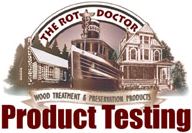
Quick click to:

Penetration Test: Ours vs. Theirs
The chart below shows the depth of penetration in balsa beams of our CPES™ (Clear Penetrating Epoxy Sealer™) and five nationally advertised products that claim to restore rot damaged wood. The exception is the “standard epoxy resin” which makes no such claims and which we included as a base standard.
In the following articles, you can read descriptions of the anonymously named products*, and exactly how we conducted the tests.
The results prove that CPES is remarkably superior in penetration ability, and therefore will reach the outermost wood fibers containing rot fungi.
*If you'd like to know the actual brand names, give us a call.
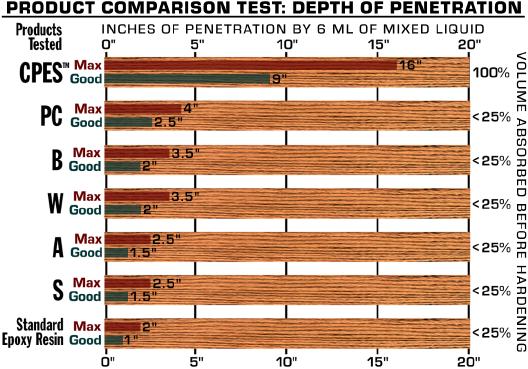
Maximum Penetration: end of wood shows 1 to 5 channels of flowing product.
Good Penetration: end of wood looks “soaked” and shows multiple channels of flowing product.
NOTE: Our original intention was to flow mixed product into the wood until it would absorb no more. Since only the CPES was absorbed 100% before curing, we limited the test to the initial 6 ml. quantity to make the test results comparable. When full flow of the CPES was allowed, we measured maximum penetration to over 20 inches (508 mm).
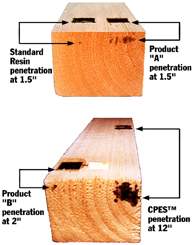
What we did…
We wanted to test the CPES against other epoxy products that are advertised to penetrate rotted wood or act as wood consolidants. We have ignored non-epoxy products (such as acrylic and polyester resin sealers) because they are not epoxy-based, and although they may make the wood hard they do not restore substantial strength and can be chemically unstable during long-term exposure to moisture. Testing the products on actual rotted wood is difficult, because of the variability of the rot and the difficulty of viewing the results. We selected soft balsa wood because it has the open grain structure typical of rotted wood, is light in color and would show product penetration.
The balsa wood was specially ordered from a Midwest hobby supply wholesaler, our criteria being that it was the lightest available and that all pieces come from the same log. Each piece was 3″ X 4″ X 36″ (76 x 102 x 914 mm). We tested all products by cutting small rectangular cavities out of the balsa which we filled with 6 ml of product dyed black.

Our original intention was to flow mixed product into the wood until it would absorb no more and then measure the inches of penetration. What happened in fact was that only the CPES was totally absorbed. The other products hardened within the cavities when 25% or less had been absorbed. So we let the 6 ml stand as the test amount.
All products were mixed and applied as per manufacturer's directions in a room temperature of 65°F (18°C) and a relative humidity of about 40%. We did multiple tests with each product to find the maximum distance that each one would penetrate with one 6 ml application to the cavity. And then we did a full flow measurement of the CPES by giving it all it would take, but included this result only as a note under the chart.
At left and bellow are photos of our test products’ penetration into soft balsa wood. None of the competitive “penetrating epoxies” penetrated very far; in all these examples, less than 25% of the 6 ml test sample was absorbed. By comparison, we show our CPES (Clear Penetrating Epoxy Sealer) penetration for 6 ml. The CPES was 100% absorbed, with a flow to over 16″ (406 mm)—a substantial difference!
This is not high science. There was no microtomy or microscopic examination. We were conservative in calculating our results, especially with the CPES. You can apply about any theoretical margin of error you wish, and it still doesn’t change the relative results and it doesn’t change the basic fact that none of the products except CPES has the ability to penetrate far enough into wood to reach the outlying fungi and the fungal spores.

The Tested Products
If you’d like to know the actual brand names of the tested products, give us a call.
PRODUCT “PC”
This is a relatively new product advertised as an “epoxy wood consolidant”. It is basically a slightly thinned epoxy resin. The mix is 2:1. There is no mention of air temperature variables. It penetrated well to 2.5″ (63.5 mm) and maximally to 4″ (102 mm). Only about 25% of the product was absorbed by the wood.
PRODUCT “B”
Primarily a marine-oriented product, product “B” claims it penetrates and saturates dry rotted wood and restores structural strength. Product “B” is a “hot” 3:1 epoxy mix and can only be mixed in small batches to avoid overheating. The optimum temperature for application is between 50–70° F (10”21°C). Mixing in temperatures above 70° F (21°C) is not recommended by the manufacturer. It penetrated well to 2″ (51 mm) and maximally to 3.5″ (89 mm). Less than 25% was absorbed by the balsa wood.
PRODUCT “W”
This product is sold exclusively through a large retail marine supply company with outlets all over the U.S. The claim is that it structurally repairs rot-damaged woods and fills hairline cracks and seals hidden leaks. Product “W” is a 3:1 mix. The product should not be used in temperatures below 50° F (10°C). It penetrated well to 2″ (51 mm) and maximally to 3.5″ (89 mm). Less than 25% of the 6 ml sample was absorbed by the balsa wood.
PRODUCT “A”
This is sold in the home/building market as an epoxy wood consolidant that penetrates and hardens rotted wood and restores structural strength. It is basically a slightly thinned epoxy resin, 50:50 mix. It will penetrate marginally better than the standard resin, but not much. It penetrated well to 1.5″ (38 mm) and maximally to 2.5″ (63.5 mm). If not allowed to sit after mixing for 5–10 minutes, the cured epoxy may have a tacky finish. The preferred temperature application range is 78–95° F (25.5–35°C), with 50° F (10°C) being the lowest without a special cold weather hardener. Less than 25% was absorbed by the balsa wood.
PRODUCT “S”
This is formulated by an epoxy manufacturer who sells largely in the marine products industry. The claim is for consolidation of rotted wood. It is a 3:1 mix. There is no mention on the package of air temperature variables. It penetrated well to 1.5″ (38 mm) and maximally to 2.5″ (63.5 mm). Less than 25% was absorbed by the wood.
STANDARD EPOXY RESIN
We used one of the main epoxy resin systems with a slow hardener. It set hard without any problems. It penetrated well to 1″ (25 mm) and maximally to 2″ (51 mm). Less than 25% was absorbed by the balsa wood.

CPES (CLEAR PENETRATING EPOXY SEALER™)
We distribute this product via the internet. It is advertised to “Restore deteriorated wood”. The product is a 50:50 two-part epoxy formula that is carried into wood by a powerful solvent mixture. The resins are derived from wood pulp, which gives them a toughness and flexibility approximating that of the original wood. It is supplied in different formulations for different temperature ranges, the lowest being down to 32°F (0°C). It penetrated well to 9″ (229 mm) and maximally to 16″ (406 mm). It was 100% absorbed. The mixed consistency is about the same as diesel fuel. It can be easily injected, as well as brushed or sprayed on bad wood. The solvent mixture has strong fumes which dissipate and leave no lingering odor.

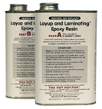

Is CPES The Perfect Product?
No, but it is the best available. Just look at it’s ability to penetrate wood. There is simply no comparison. Only the CPES penetrates far enough to reach the outer limits of the rot infusion. And if you don't get to the limits of the rot, all you are doing is filling in areas that the rot fungi have destroyed and no longer have any interest in. The leading edge of the rot may remain and regenerate at a later date.
There are miscellaneous non-epoxy “wood hardeners” on the market, such as Minwax’s “Wood Hardener” and, more recently, Bondo’s wood repair kit. Both of these are sold through mass-merchandising outlets and are intended to meet a very low price point. If you want a permanent repair of the damaged or deteriorated wood, these are basically a waste of time. The Minwax product is an acrylic with an alcohol solvent. It mixed poorly and didn’t emulsify well, lacks any kind of structural strength and will be chemically unstable after long term exposure to moisture. The Bondo wood repair kit uses styrene as the pre-treatment. This penetrated poorly and lacks structural strength (compared to our epoxy) when cured. The filler supplied is the basic Bondo polyester filler. It will get hard, but again lacks the comparative structural strength and will not withstand the expansion/contraction of wood under varying environmental conditions. It tends to crack or pop out. If you want permanent repairs, you must use epoxies, and of all the epoxies available our testing shows that our products are far superior to anything else on the market.
CPES is not a filler, except within the narrow channels in the destroyed wood cells and between rotted wood fibers. It will bind these together to form a solid, tough mass. It can be spread generously over soft or “punky” wood and the result will be hard and rot-resistant. It will penetrate through the deteriorated wood and into the first few layers of good wood behind it, adding protection from future rot infusion. One must assume that it encapsulates the fungi and the reproductive spores in epoxy resin, since it encapsulates everything else. If the deteriorated area is large and deep, we recommend following the CPES with our Layup & Laminating™ Epoxy Resin and then with the Fill-It™ Epoxy Filler. All are easy to use and can be applied and cured down to 32°F (0°C). They bond together at the molecular level to produce a structure at least as hard as the wood they replace.
We cannot claim that CPES is a fungicide. We have done no official tests to prove that it is. All we can say in this connection is that we have customers who have treated deteriorated wood with CPES, Layup & Laminating Epoxy Resin and Fill-It Epoxy Filler since the mid-1980’s and have never seen rot return. They cannot say that about other epoxy wood restoration products that they have used.
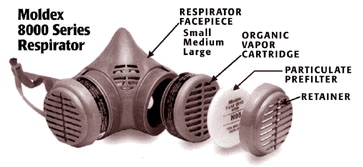
NOTE: Initially, CPES has a strong odor. We have clear statements on the web site and in our literature that warn of the hazards of breathing the concentrated fumes over a prolonged period of time. The carrier solvents are powerful. What they must do to the rot fungi and the reproductive spores we can only imagine. When using CPES we recommend the use of a respirator for organic fumes. We use and sell one by Moldex complete with cartridges in a sealed bag. We also suggest that you use vinyl gloves when you use CPES or any resin product.
A Little Biology Lesson on Wood Rot

Wood rot is caused by a variety of fungi or bacteria. They require sufficient moisture, food (the cellulose and lignin in wood fibers), oxygen, and proper temperature (fairly warm). These organisms depend on the moisture in the wood to sustain them; one type of fungus sometimes found in buildings wets the wood itself from ground moisture through a long strand called a rhizomorph.
When conditions are right, the fungi or bacteria multiply rapidly; the fungi produce spores. The fungi or bacteria reproduce and move along the easiest routes, which is usually with the wood grain. This is why the rot is usually most extensive in the same dimension as the grain of the wood. If you look closely, or section the wood, you can see that the rot penetrates deeply in thinner and thinner strands along the grain. With fungi, when and if the wood dries they can no longer survive, so they leave their reproductive spores for later regeneration. If environmental conditions within the wood again become appropriate, the spores reproduce and the rot begins once again.
This is important. It means that even though you fill a rotted area in the wood, unless the product you use has penetrated deeply along the same paths as the rot-causing organisms, the rot can return again as soon as conditions are right. Experts estimate that rot fungi and their spores exist 8–12″ (203-305 mm), or more, beyond the visible edges of the rotted wood. Any product you apply to the wood is only going to act as a filler unless it has the ability to penetrate those 8–12″ (203-305 mm) along the narrow rot channels. If it can penetrate deeply, it has a chance of reaching the outlying fungi and/or spores.
Of the products we tested, only the Clear Penetrating Epoxy Sealer was able to do this. The other products were not even close. In rotted wood or in the prevention of rot in good wood, CPES will penetrate deeper and go further than any other epoxy product available.
1. Highly magnified diagram showing hyphae of wood rotting fungus in tracheids of a softwood.
2. Longitudinal section of Scots Pine showing hyphae of the fungus.
3. Brown crumbling rot in softwood.
4. Fungal decay caused by “dry rot” fungus.
Photos and fungal diagram (1–4) borrowed from Timber Pest and Diseases by W.P.K. Findlay, Pergamon Press Ltd., ©1967.
Why is penetration so important?
“To consolidate bad wood and to reach the rot fungi or their reproductive spores, a penetrating epoxy must be capable of thoroughly infusing the bad wood and reaching to the outermost areas where the active fungi exist. Of all the products tested, only CPES meets this criteria. If a product doesn’t do this then it is just an epoxy fill, and there is always the risk that the rot will continue again under the filled area.”
—Dr. Rot
Rot Prevention in Good Wood
CPES is also a superior sealer for good wood. It penetrates the first few layers of wood fibers and seals the wood against excess moisture and the casual insect. It also penetrates all joints, cracks and vacancies and seals the adjacent wood. We never put a piece of new wood up without a coat of CPES first. It goes a long way on new wood so the expense is not outrageous. It makes a superior base for paint, varnish or urethanes. They simply stick better and last longer.
Pressure Treated Wood
We get lots of inquiries about whether pressure treated wood should be used, and if our products are compatible. First, here is some basic information about pressure treated wood.
There are multiple formulas that are commonly used to pressure treat wood. Copper Naphthenate, Chromated Copper Arsenate (CCA), Pentachlorophenol (PCP), and Alkaline Copper Quaternary (ACQ) are some of the most common. There are others as well. Some are water based, some are oil based formulas. All of these formulas protect the wood in the same way, by making the wood too toxic for wood rot fungi and wood attacking insects to survive.
They generally come in several strengths, depending on the use that the wood is intended for. For example, light duty for occasional moisture contact, medium duty for above ground exterior use, and heavy duty for ground contact use.
ACQ has come into favor for use in residential applications due to the negative press that CCA was getting. ACQ has much more copper than CCA and this copper corrodes normal exterior fasteners quickly. Therefore manufacturers recommend using either stainless steel, hot dipped galvanized or triple zinc fasteners when securing ACQ.
Unless called for by code, we generally prefer not to use pressure treated wood. For a couple of reasons. First, if the pressure treatment is very fresh, especially with some of the oil-based formulas, it can be hard to get paints and varnishes to stick to it. A more important reason is that while reputable pressure treated wood manufacturers measure their warranty in decades, they usually qualify their warranty by saying that this warranty applies only to uncut surfaces. Any cut surface must be treated by applying their formula to the exposed wood by hand. So obviously the original pressure treatment does not go all the way through the wood. The warranty of surfaces treated by hand is much lower, usually less than 10 years instead of decades, which means hand applying preservative is not as effective as the factory pressure treatment. And since almost all wood will need to be cut and/or nailed or screwed, the long factory warranty is almost never applicable. Moisture will get into the wood past the pressure treatment through the cut ends, or the nail or screw holes, and eventually rot the wood. We prefer to try to keep the moisture out of the wood in the first place. Which, if successful, means that you don’t need to use pressure treated wood to begin with.
If you have existing pressure treated wood, and you want to use our products, there is generally no reason that you can’t. As previously stated, pressure treated wood that is very fresh can be difficult to bond to. There are some creosote formulas that can ooze oils for decades, especially in warm weather. These types can be a problem to get things to stick. If you want to know whether you can reliably paint a surface, you can sprinkle a few drops of water on it. If the water beads up, the surface will need to be cleaned first. If the water spreads out and wets the surface, and is clean, it is fine to apply epoxies, paints or varnishes.
